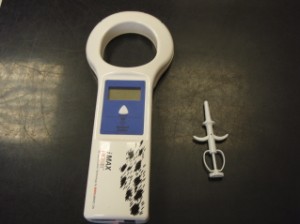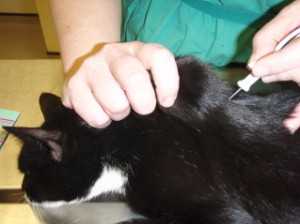Microchipping your pet
Microchipping your pet is a VERY good idea and is a must for all responsible pet owners!
Microchips are about the size of a grain of rice and are inserted under the skin at the back of the neck. They are a permenant identification of your pet, vital if they are lost, wander, or stolen. They are also a legal requirement if they are to travel outside of the UK.
What are microchips?
- Microchips are small devices, about the same size and shape as a grain of rice.
- They are injected under your pet’s skin at the scruff of their neck. The needle is quite large but the procedure is over very quickly!
- Each chip has a unique number, which can be read by a special scanner. This number is held on a central data base with all your contact details.
- Microchips are completely harmless, and once in place, are often impossible to feel. Thay cannot come out once the skin is healed and cannot be removed.
This picture shows a microchip scanner and the microchip needle. The microchip itself is only the size of a grain of rice
Why should I microchip my pet?
- All responsible pet owners should have their pets microchipped, it takes seconds and means your pet can always be identified. Cats, dogs, rabbits, and any other animals, can and should be microchipped.
- If your pet is lost or goes missing, anyone with a scanner will be able to identify them. Vets, the RSPCA, dog wardens and rescue centres all have these scanners and will scan any strays brought to them. All makes of scanners can read all makes of chips.
- There has been an increase in recent years of animals of animals being stolen. If your pet is microchipped, they will always be identifiable as yours, and if they are stolen, or there is an ownership dispute, they should be returned to you.
- It is a requirement of the PETS travel scheme that allows animas to travel abroad, that they are mircochipped.
How are they microchipped?
- The microchip is injected into the scruff, which is the loose skin on the back of your pets neck.
- It takes a matter of seconds to insert the chip, which will be in place for life.
- The needle used is large, and your pet may find it painful but it is over very quickly, and definitely worth it. If you do not wish to hold your pet, or be with them, the vet will be able to get a nurse to help them.
- A good idea is to ask the vet to chip your pet if they are under going a general anesthetic, this way they don’t feel the needle at all, and vets often charge a reduced rate.
The microchip is inserted into the animals scruff, the loose skin on the back of the neck between the shoulder blades.
Please note, this is an advice only website, if you have any specific concerns or queries about your pet, you should contact your vet.

